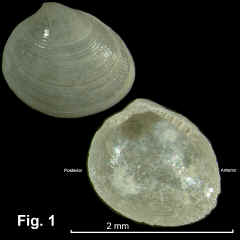|
|
NUCULIDAE |
|
|
|
Nucula mayi (Iredale, 1930) Description: Shell minute. Shape equivalve, slightly inequilateral with umbones situated a little rear of midline, inflated; anterior end broadly rounded; posterior end broadly rounded to subtruncate. Hinge taxodont, with strong teeth, up to 6 anterior and 4 posterior teeth. Chondrophore oblique. Interior with external sculpture showing through, with crenulations at ventral margin. Exterior sculptured with broad flat radial ribs, more pronounced at anterior and posterior ends; ribs separated by groves of equal width; numerous concentric striae combine with radial ribs to produce a somewhat cancellate texture over whole exterior. Periostracum thick but flaky, fawn. Exterior shell colour colourless transparent. Size: Up to 1.7 mm in length. Distribution: Endemic to Australia. Port Stephens, NSW, southwards to Cape Borda, SA, including Tas (Bergmans, 1978). Habitat: From beach wash-up down to 294?304 m. Common. It occurs with Ennucula obliqua in silty sand in less than 5 m in sheltered habitats. Synonymy: According to WoRMS (2020), the only established synonym is Pronucula cancellata Cotton, 1930. Comparison: Within the family, this species is identified by its very small size and presence of crenulations on the ventral margin internally. Remarks: This species is discussed in detail by Bergmans (1978, p. 692). The specimens shown in Fig. 1 here are from those examined by him, so the identification is fairly reliable. However, the sculpture on the left valve (i.e. the one at the top of Fig. 1) is stronger than his description admits. The crenulations on the ventral edge are poorly shown in the lower figure; they actually extend around the entire ventral edge of the shell. Fig. 1: 7608-1 25 miles (40 km) east of Twofold Bay, NSW in 294-304 m (C.100957)
|
|
